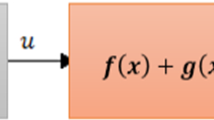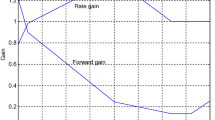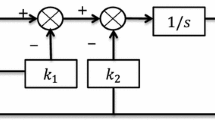Abstract
In this paper, we try to understand the dynamics involved in the launch vehicle. Then, to meet the target trajectory, we have to design a controller using modern control technique which is H-infinity control technique. The major concept of this technique is the selection of weight functions, their augmentation with the plant and develo** its state-space model. Various performance metrics used to analyse the performance of the system are gain margin, aero margin, rise time, settling time, overshoot and steady state error.
Access this chapter
Tax calculation will be finalised at checkout
Purchases are for personal use only
Similar content being viewed by others
Abbreviations
- \(T_{c}\) :
-
Control thrust in pitch plane
- \(T_{s}\) :
-
Ungimballed thrust
- I :
-
Moment of inertia of vehicle about pitch axis
- m :
-
Total mass of the launch vehicle
- \(m_0\) :
-
Reduced mass of the launch vehicle
- \(L_{\alpha }\) :
-
Aerodynamic load on launch vehicle per unit angle of attack
- \(l_{c}\) :
-
Distance from centre of mass of vehicle to engine swivel point
- \(l_{\alpha }\) :
-
Distance from the centre of mass to centre of pressure
- \(\delta \) :
-
Thrust deflection angle
- \(\alpha \) :
-
Angle of attack
- V :
-
Forward velocity of vehicle
- \(V_{w}\) :
-
Wind velocity
- \(\alpha _{w}\) :
-
Wind angle of attack
- D :
-
Drag
- \(K_{a}\) :
-
Servoamplifier gain
- \(K_{r}\) :
-
Rate gyro gain
- \(l_{pi}\) :
-
Distance from hinge point of ith pendulum to origin on body axis
- L :
-
Length of the vehicle
- \(L_{pi}\) :
-
Length of ith pendulum
- \(q^{i}\) :
-
Generalised coordinate of ith bending mode
- \(U_{0}\) :
-
Forward velocity of vehicle
- \(\mu _{c}\) :
-
Control moment coefficient: = \(\frac{Tc*l_{c}}{I_{yy}}\)
- \(\mu _{\alpha }\) :
-
Aerodynamic moment coefficient: = \(\frac{L_{\alpha }*l_{\alpha }}{I_{yy}}\)
- \(\mu _{pj}\) :
-
\(\frac{m_{pj}*l_{pj}*\dot{U_{0}}}{I_{yy}}\)
- \(\omega _{a}\) :
-
Actuator frequency
- \(\omega _{slosh}\) :
-
Slosh frequency
- \(\omega _{i}\) :
-
Frequency of ith bending mode. i = 1,2
- \(\rho \) :
-
Dam** ratio
- \(\rho _a\) :
-
Dam** ratio of actuator
- \(\rho _i\) :
-
Dam** ratio of ith bending mode. i = 1,2
References
Engelberg, S.: Tutorial 15: control theory, Part 1,2. IEEE (2008)
Bhat, M.S., Jaisimha, B.S., Kumar, S.R.V.: Optimal Digital Autopilot for Satellite Launch Vehicles During Atmospheric Phase (1992)
Arthur, L.: NASA CR-826 Analysis and Design of Space Vehicle Fight Control Systems. San Diego, California (1967)
Hespanha, J.P.: Linear Systems Theory. Princeton University
Khalate, A.A., Rao, K.K.: Robust Autopilot for Atmospheric flight of Launch Vehicle based on H H\(_{\infty }\) Approach, Centre for Artificial Intelligence and Robotics, Bangalore
Deodhare, G., Patel, V.V.: A “Modern” look at Gain and Phase margins: H\(_{\infty }/\mu \) Approach , Centre for Artificial Intelligence and Robotics, Bangalore
Wie, B., Mark, W.: Analysis and design of launch vehicle flight control systems (2008)
Author information
Authors and Affiliations
Editor information
Editors and Affiliations
Rights and permissions
Copyright information
© 2022 The Author(s), under exclusive license to Springer Nature Singapore Pte Ltd.
About this chapter
Cite this chapter
Vaishnavi, C., Dhekane, M.V. (2022). Launch Vehicle Autopilot Design Using H-Infinity Control Technique. In: Gu, J., Dey, R., Adhikary, N. (eds) Communication and Control for Robotic Systems. Smart Innovation, Systems and Technologies, vol 229. Springer, Singapore. https://doi.org/10.1007/978-981-16-1777-5_27
Download citation
DOI: https://doi.org/10.1007/978-981-16-1777-5_27
Published:
Publisher Name: Springer, Singapore
Print ISBN: 978-981-16-1776-8
Online ISBN: 978-981-16-1777-5
eBook Packages: EngineeringEngineering (R0)




